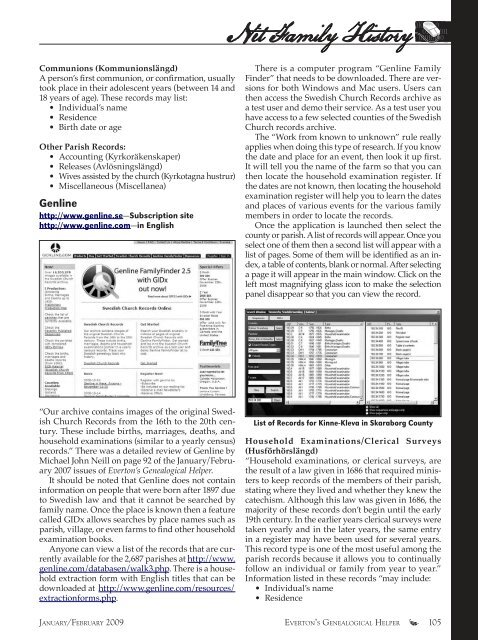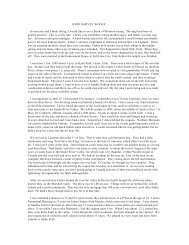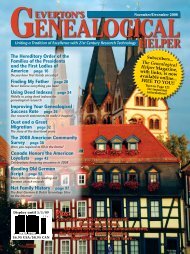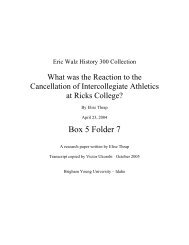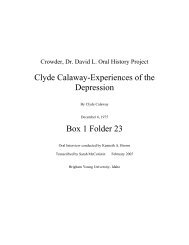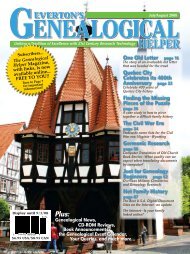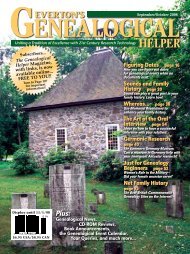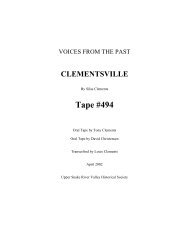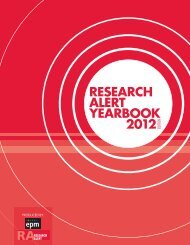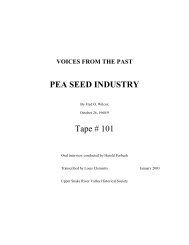HelPeR - BYU Idaho Special Collections and Family History
HelPeR - BYU Idaho Special Collections and Family History
HelPeR - BYU Idaho Special Collections and Family History
You also want an ePaper? Increase the reach of your titles
YUMPU automatically turns print PDFs into web optimized ePapers that Google loves.
Net <strong>Family</strong> <strong>History</strong> 010 01 0<br />
101<br />
01010100<br />
Communions (Kommunionslängd)<br />
A person’s first communion, or confirmation, usually<br />
took place in their adolescent years (between 14 <strong>and</strong><br />
18 years of age). These records may list:<br />
• Individual’s name<br />
• Residence<br />
• Birth date or age<br />
Other Parish Records:<br />
• Accounting (Kyrkoräkenskaper)<br />
• Releases (Avlösningslängd)<br />
• Wives assisted by the church (Kyrkotagna hustrur)<br />
• Miscellaneous (Miscellanea)<br />
Genline<br />
http://www.genline.se—Subscription site<br />
http://www.genline.com—in English<br />
There is a computer program “Genline <strong>Family</strong><br />
Finder” that needs to be downloaded. There are versions<br />
for both Windows <strong>and</strong> Mac users. Users can<br />
then access the Swedish Church Records archive as<br />
a test user <strong>and</strong> demo their service. As a test user you<br />
have access to a few selected counties of the Swedish<br />
Church records archive.<br />
The “Work from known to unknown” rule really<br />
applies when doing this type of research. If you know<br />
the date <strong>and</strong> place for an event, then look it up first.<br />
It will tell you the name of the farm so that you can<br />
then locate the household examination register. If<br />
the dates are not known, then locating the household<br />
examination register will help you to learn the dates<br />
<strong>and</strong> places of various events for the various family<br />
members in order to locate the records.<br />
Once the application is launched then select the<br />
county or parish. A list of records will appear. Once you<br />
select one of them then a second list will appear with a<br />
list of pages. Some of them will be identified as an index,<br />
a table of contents, blank or normal. After selecting<br />
a page it will appear in the main window. Click on the<br />
left most magnifying glass icon to make the selection<br />
panel disappear so that you can view the record.<br />
“Our archive contains images of the original Swedish<br />
Church Records from the 16th to the 20th century.<br />
These include births, marriages, deaths, <strong>and</strong><br />
household examinations (similar to a yearly census)<br />
records.” There was a detailed review of Genline by<br />
Michael John Neill on page 92 of the January/February<br />
2007 issues of Everton’s Genealogical Helper.<br />
It should be noted that Genline does not contain<br />
information on people that were born after 1897 due<br />
to Swedish law <strong>and</strong> that it cannot be searched by<br />
family name. Once the place is known then a feature<br />
called GIDx allows searches by place names such as<br />
parish, village, or even farms to find other household<br />
examination books.<br />
Anyone can view a list of the records that are currently<br />
available for the 2,687 parishes at http://www.<br />
genline.com/databasen/walk3.php. There is a household<br />
extraction form with English titles that can be<br />
downloaded at http://www.genline.com/resources/<br />
extractionforms.php.<br />
List of Records for Kinne-Kleva in Skaraborg County<br />
Household Examinations/Clerical Surveys<br />
(Husförhörslängd)<br />
“Household examinations, or clerical surveys, are<br />
the result of a law given in 1686 that required ministers<br />
to keep records of the members of their parish,<br />
stating where they lived <strong>and</strong> whether they knew the<br />
catechism. Although this law was given in 1686, the<br />
majority of these records don’t begin until the early<br />
19th century. In the earlier years clerical surveys were<br />
taken yearly <strong>and</strong> in the later years, the same entry<br />
in a register may have been used for several years.<br />
This record type is one of the most useful among the<br />
parish records because it allows you to continually<br />
follow an individual or family from year to year.”<br />
Information listed in these records “may include:<br />
• Individual’s name<br />
• Residence<br />
Ja n ua ry/Fe b r u a r y 2009 Ev e r t o n’s Ge n e a l o g i c a l He l p e r © 105


